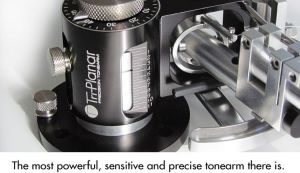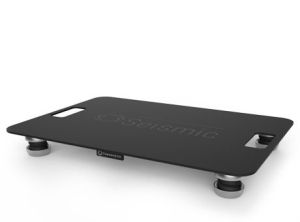
More Commentaries and Advice on Equipment
Advice on Making Audio Progress
Below you will find a list of most of the equipment we have been using over the years to carry out our Hot Stamper pressing evaluations, or “shootouts” as we like to call them.
Of course the old 80/20 Rule comes into play here — 80% (probably more like 90 or 95%, truth be told) of the sound is what you do with your audio system, 20% (or 10 or 5%) of the sound is the result of the components you own.
We like to say it’s not about the audio you have, it’s about the audio you do: how you set up your system, what you’ve done to treat your room, how good your electricity is and all the rest of it.
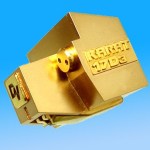 Our VPI Aries (original, not the latest model) with Super Platter (no longer made) and TTWeights Carbon Fiber Platter (a big upgrade, no longer made) / VPI Synchronous Drive System (as of 2016 now sitting on a Townshend Seismic Sink) Triplanar Tonearm / Dynavector 17d3 [now 17dx] / Aurios (no longer made), which sit on a Townshend Seismic Sink (another big upgrade, contact me if interested) / EAR 324P and the hundreds of hours we’ve spent setting up and tweaking this beast is at the heart of everything we do around here.
Our VPI Aries (original, not the latest model) with Super Platter (no longer made) and TTWeights Carbon Fiber Platter (a big upgrade, no longer made) / VPI Synchronous Drive System (as of 2016 now sitting on a Townshend Seismic Sink) Triplanar Tonearm / Dynavector 17d3 [now 17dx] / Aurios (no longer made), which sit on a Townshend Seismic Sink (another big upgrade, contact me if interested) / EAR 324P and the hundreds of hours we’ve spent setting up and tweaking this beast is at the heart of everything we do around here.
We love our modified Legacy Focus speakers, even more now that they have much improved high frequency extension courtesy of Townshend Super Tweeters.
Mix in extensive room treatments, aided inestimably by three pairs of Hallographs (as we like to say, there is no practically no Hi-Fi without them), more than thirty years of experience and endless hours of experimentation and you have a system that can separate the winners from the losers like nobody’s business.
Exactly like nobody’s business, because nobody does it in this business but us. Having heard hundreds of systems over the years, it’s an open question as to whether anyone else could do what we do.
The Benefits of Low Power Amps
Our preamp and amp are vintage and low power; the Focus can play quite loudly with the thirty-five watts our amp puts out. We are big fans of Low Power (but not single ended) and are not the least bit happy with the current trend toward high-power amps, whether tube or transistor. I remember well when this trend started in the early ’70s with the Phase Linear 400 amp. It has only gotten worse with each passing year.
 A few years back we tried using higher power amps when doing shootouts for the likes of Nirvana, AC/DC and such. We found that using a bigger amp involved major trade-offs, trade-offs (opacity; loss of transient information, spaciousness and ambience) whose costs far exceeded their benefits.
A few years back we tried using higher power amps when doing shootouts for the likes of Nirvana, AC/DC and such. We found that using a bigger amp involved major trade-offs, trade-offs (opacity; loss of transient information, spaciousness and ambience) whose costs far exceeded their benefits.
With more power comes less Tubey Magic, sweetness, transparency, three-dimensionality and that wonderful relaxed quality which allows the music to flow. High power amps in our experience do none of these things well. As most speakers today are terribly inefficient, they require the use of high power amps, a choice most audiophiles do not even know they are making when they buy inefficient speakers.
If you own large power amps, there is a very good chance you do not know what you are missing.
Most of our wiring — interconnect and speaker (the Triplanar is hardwired with a top quality phono interconnect) — is custom, although we recommend certain power cords when you buy specific equipment from us (such as the EAR phono stages). We occasionally engage in audiophile wire-bashing in our commentaries.
And Why You Shouldn’t Care
Having said that, we don’t think you should care a whit about what equipment we use.
No, I take that back. Let’s be honest. The equipment we’ve listed is the equipment we use and recommend because it’s the best equipment we have had the opportunity to audition, or managed to acquire, or happened to come our way, and was affordable at the time. In truth, it was some combination of the above. It’s what works for us.
The bulk of audiophile equipment we have auditioned over the last thirty plus years would make our famous Hot Stamper shootouts difficult to carry out.
Most of it sounds far too colored, limited and often — not to put too fine a point on it — just plain wrong.
This commentary about the music of The Beatles targets the issue, but in hundreds of our listings we try to help the reader/ listener focus specifically on what a recording should be doing in the home. The better your equipment and room, the better your Hot Stamper pressing will be able to do what we know it can do.
If you would like to hear your records sound their best, we would love to help you accomplish that goal. There is no greater thrill than hearing your favorite music sound better than you ever thought possible. It’s what Hot Stampers are all about. And the right equipment is a big part of that better-than-you-ever-thought-possible sound. Not the biggest part; the biggest part is you.
Still, a very big part.
A Good Record Is an Education
A good record is an education for us too. This is not only how we’ve managed to learn about the pressing in question; it’s the same process that allows us to make improvements in the sound of the stereo. It’s learning how to identify what is right and what is wrong with the sound of any pressing — the same process that helps us recognize whether any change to the stereo makes it sound better or worse, and to try and figure out by how much and in what way.
And the best part is, like the practice of any skill, the more you do it, the better you get at it. We do it all day, every day. Not because we’re noble or dedicated. We do it because we enjoy it. It’s fun. It’s the most fun part of this job. Discovering great sounding recordings is a THRILL. It’s what this hobby is all about — hearing music sound better than you ever thought it could.
Change For The Better
Of course, as I’ve stated elsewhere on the site, you learn almost nothing from the same record played back on the same equipment. What you must do is learn to listen for differences in the sound, and differences only come about as the result of a change. You have to CHANGE something in the system to develop your critical listening skills.
How about this example: the difference in sound between any two sides of a record. The only change there involves flipping the record over. No new equipment, no tweaks, no shootouts with dozens of alternate pressings. Just flip the record. Most records do not have the same sound on both sides, not the records we play anyway, and we play them by the thousands.
Where else have you ever read such a thing? Nowhere else, at least to our knowledge. Because few audiophiles and almost no record dealers make the effort to listen critically at anything approaching this level of scrutiny.
Training Your Ears
If you can’t hear the difference on at least some of your records, it has to be one or both of the following. Either your system is not good enough to resolve these differences, which is sometimes the case, or, much more likely, you simply haven’t trained your ears to listen for them.
This has nothing to do with listening for pleasure. This is listening like it’s a job. Critically. Analytically.
Try to listen for one quality by itself. Listen for grain, or top end extension, or bass, or dynamics — anything, the list is endless. Focus in on that single quality, recognize it, appreciate it, then flip the record over and judge that one quality for side two.
Cheap Tables
There is a minimum level of resolution your front end must attain before these differences are important. With a cheap rig you certainly don’t need us to find records for you. (More on the limitations of cheap tables here.)
Many of the records we praise highly present a severe test for a playback system, one that less sophisticated setups will have a hard time passing. Sergio Mendes’ records come readily to mind. You need to have one helluva well-setup, high-quality front end before you can play them without sibilance and grain, let alone bring out all the magic. I don’t know a tougher test than Stillness, or Sergio Mendes & Brasil ‘66. They will bring most stereos to their knees, mine included if I haven’t tuned it right.
Better in What Way?
Much of the commentary on the site is there to explain how to differentiate the better pressings from the not-so-better pressings. The better the system, and the more careful the listener, the more these differences will matter. That’s why we charge so much money for the really hot copies – to us, they are worlds better than the runners-up.
They are right in a way that the typical half-speed mastered or heavy vinyl pressing rarely is. The more critically one listens, the more obvious this distinction becomes. The real thing just can’t be beat, and you can be pretty sure that the real thing is an old record.
Not just any old record of course. It needs to have been cleaned properly, mastered properly and pressed properly. Ideally it should have Hot Stampers, but that is not a requirement for top quality sound. Lots of old records have top quality sound, but not all of them have Hot Stampers. (More on that subject here.)

(more…)
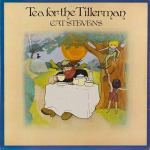


 Our VPI Aries (original, not the latest model) with Super Platter (no longer made) and TTWeights Carbon Fiber Platter (a big upgrade, no longer made) / VPI Synchronous Drive System (as of 2016 now sitting on a Townshend Seismic Sink) Triplanar Tonearm / Dynavector 17d3 [now 17dx] / Aurios (no longer made), which sit on a Townshend Seismic Sink (another big upgrade, contact me if interested) / EAR 324P and the hundreds of hours we’ve spent setting up and tweaking this beast is at the heart of everything we do around here.
Our VPI Aries (original, not the latest model) with Super Platter (no longer made) and TTWeights Carbon Fiber Platter (a big upgrade, no longer made) / VPI Synchronous Drive System (as of 2016 now sitting on a Townshend Seismic Sink) Triplanar Tonearm / Dynavector 17d3 [now 17dx] / Aurios (no longer made), which sit on a Townshend Seismic Sink (another big upgrade, contact me if interested) / EAR 324P and the hundreds of hours we’ve spent setting up and tweaking this beast is at the heart of everything we do around here. A few years back we tried using higher power amps when doing shootouts for the likes of Nirvana, AC/DC and such. We found that using a bigger amp involved major trade-offs, trade-offs (opacity; loss of transient information, spaciousness and ambience) whose costs far exceeded their benefits.
A few years back we tried using higher power amps when doing shootouts for the likes of Nirvana, AC/DC and such. We found that using a bigger amp involved major trade-offs, trade-offs (opacity; loss of transient information, spaciousness and ambience) whose costs far exceeded their benefits.
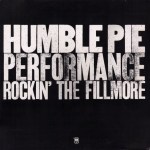
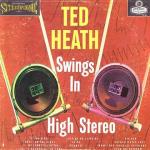


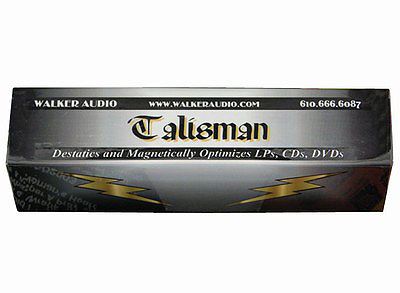 Tom,
Tom,